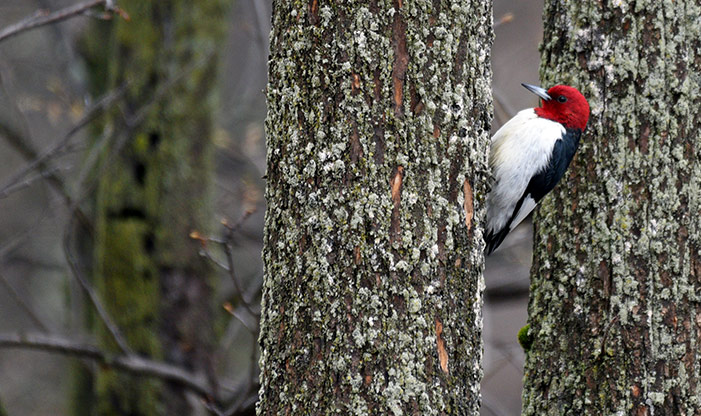For some animals, there is a story contained in their name. The simple name “woodpecker” is one example. It’s a starting point for how these birds spend a great deal of their time. The names of some woodpeckers, such as the Red-headed, Red-bellied, and Yellow-bellied Sapsucker, probably don’t need further explanation. However, four other woodpeckers found at Schlitz Audubon have marvelous stories within their names.
For example, the Downy Woodpecker has softer feathers than those of a bird that possesses a rougher tactile sensation, the so named Hairy Woodpecker. The Pileated Woodpecker wears a brilliant red atop its head, and In Latin, the word pileated translates to cap. The Northern Flicker tells us its name by its calls, which sounds similar to, “Flick-a, Flick-a, Flick-a…”
Woodpecker Songs are Created by the Bird’s Pecking
Perhaps woodpeckers themselves tell the most incredible story, as we hear their pecking sounds echoing through the forest. Woodpeckers peck on trees for three main reasons. The first reason is to establish a territory, exclusive of other males of its species. This is called drumming, and it’s similar to why male songbirds “sing.” This rapid and loud sound is distinct to woodpeckers, and it can occasionally serve the alternate purpose of attracting females.
Secondly, they peck to find insect larvae beneath bark to eat. How do they know which trees to peck? Woodpeckers can hear the insects moving beneath the bark.
The third reason woodpeckers peck is to excavate a new cavity nest. When doing this they pack the most punch into their peck. Woodpeckers possess zygodactyl feet, which means they have four toes, two pointing forward and two pointing backward. With this toe arrangement, they’re able to climb up and down and cling to the bark of a tree for long periods of time while drumming or pecking.
Woodpeckers with the most curved beaks, like the Northern Flicker, typically do the least drumming. The Northern Flicker is more of a ground foraging bird that dines on ants. All woodpeckers eat their preferred insects, and then supplement diets with nuts and berries, as well as their less preferred insects.
Woodpeckers Peck without Injury
Woodpeckers possess four main adaptations that allow them to spend their life pecking away without incurring physical trauma. Most importantly, woodpeckers possess a hyoid, which is a spongy bone that helps to distribute the force throughout their skull. They have a barbed tongue that is so long it wraps around their skull – up to five inches long. If our tongues were proportionate to that of a woodpecker, human tongues would be nearly as long as we are tall! While hard, their beak also has elastic and shock-absorbent qualities. In addition, their brains are packed tightly inside their skulls, with minimal cerebrospinal fluid to transmit energy.
A Unique Flying Style
As woodpeckers make their way through the forest, they have a unique style of flying. You can spot a woodpecker in flight by the way they undulate up and down as they beat their wings a few short times, then tuck them in against their body briefly before continuing to beat their wings. Woodpecker wings are specially adapted to fly in and out of densely packed forests.
One of the recent stories told by woodpeckers in our region is that of the Emerald Ash Borer Beetle (EAB). When it comes to EAB, woodpeckers are the town crier. In spring 2016, they told us EAB was affecting our ash trees. Over the next few years, while EAB plagues ash trees, we will likely see a spike in woodpecker populations.
It may seem counter-intuitive, but strategically leaving dead ash trees standing will provide homes for innumerable plants, animals, and fungi. Decaying ash trees provide construction sites for cavity nests. Woodpeckers excavate a new nest every year, and dozens of animals will take advantage of last year’s real estate.
When the generally less flashy palette of winter arrives, woodpeckers provide a subtle dash of color to the landscape. Amidst freshly fallen snow, they will continue to talk about the forest to anyone that takes the time to enjoy their stories.


